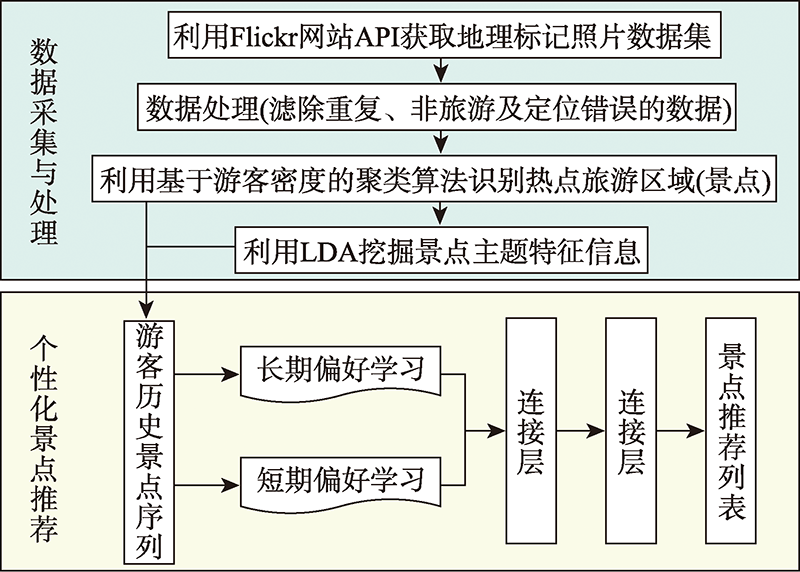

Journal of Geo-information Science >
A Personalized Attraction Recommendation Method based on Geotagged Photos
Received date: 2020-10-15
Request revised date: 2020-12-25
Online published: 2021-10-25
Supported by
Qishan Scholar Award Support Scheme(XRC-19001)
National Key Research and Development Project(2017YFB0504202)
Copyright
Personalized recommendation of tourist attractions for visitors is useful based on the vast amount of tourism information and data. In this paper, we use Flickr's geotagged photos from 2013 to 2018 in Hong Kong to identify tourist hot spots and reconstruct the tourism trajectory according to the tourist visiting order. On this basis, we propose a personalized recommendation method based on Latent Dirichlet Allocation (LDA) model and User's Long-term and Short-term Preference (L-ULSP) to address the problem that existing methods do not take into account the dynamic changes in visitor preferences during the travel process. In this method, the LDA model is used to obtain the feature information of attractions, and the correlation between attractions is explored. Then, attention mechanism is used to focus on the important information in the long-term sequence to capture the long-term preference of tourists, and LSTM is used to model the short-term sequence information to learn the short-term preference of tourists. Finally, the long-term and short-term preferences are weighted to obtain the final preferences of tourists to capture the dynamic changes of user preferences. The algorithm has the following advantages: (1) By mining the topic feature information of Geotagged photo text, the description information of attractions is added, which can capture users' travel preference more accurately; (2) The algorithm considers both the long-term and short-term preferences of users, and can learn the dynamic changes of users' preferences in the process of travel while modeling the sequence information of attractions. The experimental results show that: (1) The attractions recommended by the L-ULSP method outperform other existing methods in both Hit Rate and Mean Reciprocal Rank, two common evaluation metrics for recommendation algorithms, proving that the proposed method can effectively learn visitor preferences from a sequence of attractions and recommend the next attraction to visitors. It is demonstrated that the method can achieve good recommendation results in travel recommendation scenarios; (2) The comparison experiments between the model using long-term preference as the user's final preference and the model combining user's long-term and short-term preferences as the final preference further validate that considering both the user's long-term and short-term preferences can better learn the user's preference changes and thus improve the accuracy of recommendations; (3) This paper further compares the calculation efficiency of L-ULSP with different deep learning recommendation models based on RNN, and counts the running time of each model. The results show that this method is better than most methods in efficiency.

YE Fan , SUN Yu , CHEN Chongcheng , YU Dayu . A Personalized Attraction Recommendation Method based on Geotagged Photos[J]. Journal of Geo-information Science, 2021 , 23(8) : 1391 -1400 . DOI: 10.12082/dqxxkx.2021.200608
表2 各数据处理步骤后的游客数量和记录数量Tab. 2 Number of tourists and records after each data processing procedure |
| 数据处理步骤 | 游客数/位 | 记录数/个 |
|---|---|---|
| 滤除非香港行政区划数据后 滤除重复数据后 滤除非游客数据后 滤除定位错误数据后 | 8898 8898 8165 8165 | 280 361275 252142 261137 671 |
图3 2013—2018年香港特别行政区地理标记照片空间分布Fig. 3 Spatial distribution of geotagged photos in HongKong from 2013 to 2018 |
图4 中心城区不同参数下形成的簇数Fig. 4 The number of clusters detected with different value of parameters in central area |
图5 非中心城区不同参数下形成的簇数Fig. 5 The number of clusters detected with different value of parameters in non-central area |
表3 不同算法的推荐结果对比Tab. 3 Comparison of recommendation results of different algorithms |
| 方法 | HR@10 | MRR@10 |
|---|---|---|
| POP SKNN FPMC FOSSIL GRU4Rec NARM STAMP L-ULSP | 20.6930.7935.4441.5441.3844.8342.6746.63 | 7.739.5911.8218.2720.6721.2722.6724.64 |
表4 用户长短期偏好的影响Tab. 4 The impact of long and short-term preferences |
| Model | HR@5 | MRR@5 | HR@10 | MRR@10 | HR@20 | MRR@20 |
|---|---|---|---|---|---|---|
| L-ULP L-ULSP | 33.1735.81 | 19.2723.23 | 44.7146.63 | 20.8724.64 | 53.6156.73 | 21.4925.33 |
表5 不同模型的运行时间对比Tab. 5 Running time comparison of different models |
| Model | Runtime/s |
|---|---|
| GRU4Rec NARM STAMP L-ULSP | 91.55 239.05 68.67 76.24 |
本文对比方法的代码来源于原论文作者公开的代码,在此表示感谢。
| [1] |
|
| [2] |
|
| [3] |
|
| [4] |
|
| [5] |
|
| [6] |
|
| [7] |
|
| [8] |
|
| [9] |
|
| [10] |
|
| [11] |
|
| [12] |
|
| [13] |
|
| [14] |
|
| [15] |
|
| [16] |
|
| [17] |
|
| [18] |
|
| [19] |
李昇智, 乔建忠, 林树宽. 一种基于用户移动行为相似性的位置预测方法[J]. 计算机科学, 2018, 45(12):288-292,307.
[
|
| [20] |
|
| [21] |
|
| [22] |
|
| [23] |
|
| [24] |
|
| [25] |
|
| [26] |
|
| [27] |
|
| [28] |
|
| [29] |
|
| [30] |
|
| [31] |
|
/
| 〈 |
|
〉 |